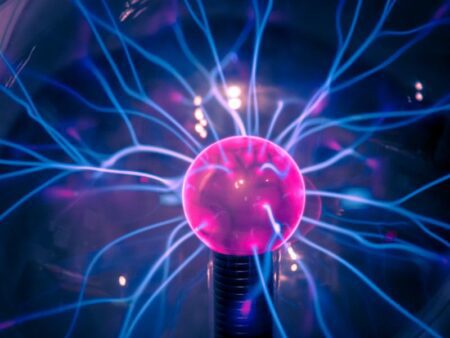
In the Japanese art of kintsugi, an artist takes the broken shards of a bowl and fuses them back together with gold to make a final product more beautiful than the original. That idea is inspiring a new approach to managing plasma, the super-hot state of matter, for use as a power source, writes Rachel Kremen of Princeton Plasma Physics Laboratory (PPPL).
Scientists are using the imperfections in magnetic fields that confine a reaction to improve and enhance the plasma in an approach outlined in a new paper in the journal Nature Communications.
“This approach allows you to maintain a high-performance plasma, controlling instabilities in the core and the edge of the plasma simultaneously. That simultaneous control is particularly important and difficult to do. That’s what makes this work special,” said Joseph Snipes of the US Department of Energy’s (DOE) Princeton Plasma Physics Laboratory (PPPL). He is PPPL’s deputy head of the Tokamak Experimental Science Department and was a co-author of the paper.
Have you read?
Fluor and Longview start design work on laser fusion plant
Tennessee’s Bull Run coal plant gets second life as fusion energy pilot
PPPL Physicist Seong-Moo Yang led the research team, which spans various institutions in the US and South Korea. Yang says this is the first time any research team has validated a systematic approach to tailoring magnetic field imperfections to make the plasma suitable for use as a power source. These magnetic field imperfections are known as error fields.
“Our novel method identifies optimal error field corrections, enhancing plasma stability,” Yang said. “This method was proven to enhance plasma stability under different plasma conditions, for example, when the plasma was under conditions of high and low magnetic confinement.”
Errors that are hard to correct
Error fields are typically caused by minuscule defects in the magnetic coils of the device that holds the plasma, which is called a tokamak. Until now, error fields were only seen as a nuisance because even a very small error field could cause a plasma disruption that halts fusion reactions and can damage the walls of a fusion vessel. Consequently, fusion researchers have spent considerable time and effort meticulously finding ways to correct error fields.
“It’s quite difficult to eliminate existing error fields, so instead of fixing these coil irregularities, we can apply additional magnetic fields surrounding the fusion vessel in a process known as error field correction,” Yang said.
In the past, this approach would have also hurt the plasma’s core, making the plasma unsuitable for fusion power generation. This time, the researchers were able to eliminate instabilities at the edge of the plasma and maintain the stability of the core. The research is a prime example of how PPPL researchers are bridging the gap between today’s fusion technology and what will be needed to bring fusion power to the electrical grid.
“This is actually a very effective way of breaking the symmetry of the system, so humans can intentionally degrade the confinement. It’s like making a very tiny hole in a balloon so that it will not explode,” said SangKyeun Kim, a staff research scientist at PPPL and paper co-author. Just as air would leak out of a small hole in a balloon, a tiny quantity of plasma leaks out of the error field, which helps to maintain its overall stability.
Managing the core and the edge of the plasma simultaneously
One of the toughest parts of managing a fusion reaction is getting both the core and the edge of the plasma to behave at the same time. There are ideal zones for the temperature and density of the plasma in both regions and hitting those targets while eliminating instabilities is tough.
This study demonstrates that adjusting the error fields can simultaneously stabilize both the core and the edge of the plasma. By carefully controlling the magnetic fields produced by the tokamak’s coils, the researchers could suppress edge instabilities, also known as edge localised modes (ELMs), without causing disruptions or a substantial loss of confinement.
“We are trying to protect the device,” said PPPL Staff Research Physicist Qiming Hu, an author of the paper.
Extending the research beyond KSTAR
The research was conducted using the KSTAR tokamak in South Korea, which stands out for its ability to adjust its magnetic error field configuration with great flexibility. This capability is crucial for experimenting with different error field configurations to find the most effective ones for stabilising the plasma.
The researchers say their approach has significant implications for the design of future tokamak fusion pilot plants, potentially making them more efficient and reliable. They are currently working on an artificial intelligence (AI) version of their control system to make it more efficient.
“These models are fairly complex; they take a bit of time to calculate. But when you want to do something in a real-time control system, you can only afford a few milliseconds to do a calculation,” said Snipes. “Using AI, you can basically teach the system what to expect and be able to use that artificial intelligence to predict ahead of time what will be necessary to control the plasma and how to implement it in real-time.”
While their new paper highlights work done using KSTAR’s internal magnetic coils, Hu suggests future research with magnetic coils outside of the fusion vessel would be valuable because the fusion community is moving away from the idea of housing such coils inside the vacuum-sealed vessel due to the potential destruction of such components from the extreme heat of the plasma.
Researchers from the Korea Institute of Fusion Energy (KFE), Columbia University and Seoul National University were also integral to the project.
Originally published on pppl.gov.








